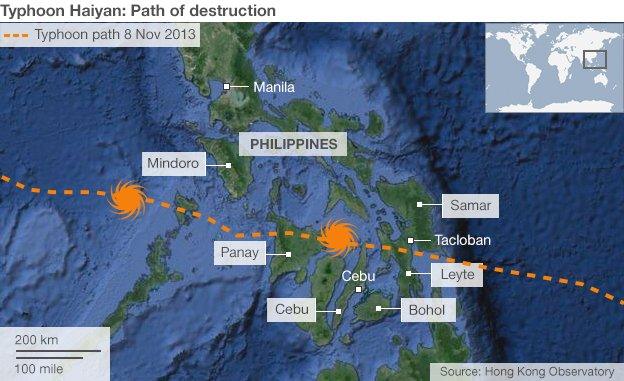Typhoon Haiyan: BBC reports from the Philippines
- Published
BBC correspondents are in some of the places worst hit by Typhoon Haiyan in the Philippines. Below is a selection of their reports on the devastation and the rescue operation.
Tacloban, 19 November: Patients queue for medical help
Rajesh Mirchandani visits a field hospital set up by German and Belgian medics in Palo, near Tacloban
The BBC's Rajesh Mirchandani takes a look around a field hospital set up by German and Belgian medics in Palo, near Tacloban
Guiuan, 17 November: Desperate scramble for aid from the air
Rajini Vaidyanathan reports from a US helicopter as it distributes aid to remote areas.
Filipinos desperately scramble for aid which is starting to arrive from the air, as Rajini Vaidyanathan reports
Tacloban, 15 November: The view of the devastation from a helicopter
The BBC's Rajesh Mirchandani says that from the air the city of Tacloban is in ruins one week on.
The BBC's Rajesh Mirchandani says that from the air the city of Tacloban still lies in ruins
Guiuan, 14 November: Desolation where the typhoon first hit land
Andrew Harding reaches the isolated villages where the typhoon first struck.
The BBC's Andrew Harding: "The very first encounter between storm and land. Not much of a contest"
Island of Leyte, 14 November: Devastation beyond the city
Alastair Leithead says people are still waiting for aid on the island of Leyte almost a week after Typhoon Haiyan hit.
The BBC's Alastair Leithead surveys the scene on the island of Leyte
Tacloban, 14 November: International aid 'finally arrives'
International aid finally reaches Tacloban as the city buries the dead, reports Rupert Wingfield-Hayes.
The BBC's Rupert Wingfield-Hayes: "There has been a dramatic change today"
Island of Leyte, 13 November: Joyful reunion amid typhoon anguish
The BBC's Alastair Leithead meets two sisters in search of their parents, as he took a boat from a remote part of Cebu to the island of Leyte.
The BBC's Alastair Leithead took a boat from a remote part of Cebu to the island of Leyte
Tacloban, 13 November: Trapped teenager loses entire family
Rupert Wingfield-Hayes meets a 13-year-old girl who lost her entire family in the disaster.
The BBC's Rupert Wingfield Hayes met a teenager who spent six days trapped alongside her dead family
Tacloban, 13 November: Churches become sanctuaries for homeless
Churches have become havens for people whose homes have been ripped apart, as George Alagiah reports.
The BBC's George Alagiah: "A place for prayer now a place for sanctuary"
Tacloban, 13 November: At the airport as aid finally arrives
Impassable roads means that delivering aid by air has become essential, as Jonathan Head reports.
Jonathan Head reports from Tacloban airport as aid begins to arrive
Tacloban, 13 November: Inside hospital that lacks basic supplies
Rupert Wingfield-Hayes reports from a hospital that was completely flooded by the typhoon and lacks basic supplies and clean water.
The BBC's Rupert Wingfield-Hayes reports from inside a Tacloban hospital
Tacloban, 13 November: Life at a makeshift shelter
Jon Donnison speaks to Jose, who is living inside a sports centre that is doubling up as a makeshift shelter for victims of the disaster.
Tacloban resident: "People of the world, come to my city. We need help very badly"
Tacloban, 12 November: Desperate queues for food
Rupert Wingfield-Hayes reports on the wait for aid in Tacloban where some looting occurred on the fifth day after the typhoon.
Rupert Wingfield-Hayes reports on the wait for aid in Tacloban
Cebu, 12 November: Devastation witnessed from the air
The BBC's George Alagiah makes a helicopter journey over devastated areas.
George Alagiah looks out from a helicopter at the damage caused by Typhoon Haiyan
Tacloban, 12 November: Hungry survivors ransack warehouse
Jon Donnison reports from one of the worst-hit areas of Tacloban, where desperation for food has taken hold.
Jon Donnison: "People are desperate to get hold of whatever food they can"
Tacloban, 12 November: On street destroyed by wall of water
Jon Donnison meets residents picking up the pieces in one of the worst hit areas of Tacloban.
The BBC's Jon Donnison reports from a street destroyed by "a wall of water"
Cebu International Airport, 12 November: Aid planes stranded
Tim Willcox explains why planes carrying aid are being delayed from reaching the disaster zone.
Planes carrying aid are stuck on the tarmac in Cebu, as BBC correspondent Tim Willcox reports
Tacloban, 12 November: Queuing for food in stinking black water
Rupert Wingfield-Hayes reports from the flood waters in Tacloban, which are making conditions even worse for survivors.
BBC correspondent Rupert Wingfield-Hayes reports on the "stinking black water" left behind
Cebu, 12 November: How pair survived as house flattened
Alistair Leithead reports on one survival story from a street on the island of Cebu.
BBC correspondent Alastair Leithead: "The typhoon came into this building, ripped off the roof and tossed it 500 metres away"
Tacloban, 11 November: Families bury relatives
Rupert Wingfield-Hayes reports on relatives carrying victims on foot to a burial ground in Tacloban.
Rupert Wingfield-Hayes reports from Tacloban where families have to bury their own dead
Manila, 11 November: Inside makeshift typhoon aid centre
George Alagiah is at a makeshift aid distribution centre at Manila airport.
The BBC's George Alagiah reports from a makeshift distribution centre at Manila airport
Tacloban airport, 11 November: People queue to escape
Hundreds of desperate people are queuing to get out of Tacloban, says Jonathan Head.
"My house is totally gone, there is nothing left"
Cebu, 11 November: Towns suffer "80-90% damage"
Alistair Leithead is in Cebu province, where some towns suffered "80-90% damage", according to one disaster worker.
The BBC's Alistair Leithead reports from Cebu province, where some towns have suffered "80-90% damage"
Tacloban, 10 November: Buildings destroyed
An estimated 80% of Tacloban has been destroyed, Rupert Wingfield-Hayes reports.
“An enormous four-metre storm surge swept into the coast, crushed all of these buildings”, reports Rupert Wingfield-Hayes
